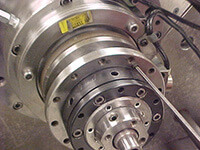Trim balance is the final balance procedure done to a spindle after assembly and during full speed testing. This is procedure is necessary for two reasons. One, often additional components are attached to the shaft after assembly into the housing. Their imbalance will not be compensated for by the adjustments made on the Balancing Machine.

Installing a set screw into a balance ring on an OKK spindle
Second, the balance machine is only capable of rotating the shafts are rather low speed; typically around 1000 RPMs. Trim balancing is performed at full operational speed; often in excess of 12,000 RPMS and sometimes as high as 60,000 RPMS.
Compliance with ISO 1940/1 requires operation and testing at higher speeds than can be achieved on the balancing machine.
Rotational speed is an important factor in balancing. A spindle that has excellent balance readings at 1000 RPMs may fail badly at 12,000 RPM. Additionally, there may be certain harmonics that generate high g readings at intermediate RPMS. So to guarantee acceptable readings through the full operational range of the spindle proper trim balancing is essential.
Often high end spindles have balancing rings with series of tapped holes around the periphery allowing the addition of various sized set screws. Appropriate installation of these set screws allows a trained technician to virtually eliminate the effects of residual imbalance.
Trim balance is the final balance procedure done to a spindle after assembly and during full speed testing. This is procedure is necessary for two reasons. One, often additional components are attached to the shaft after assembly into the housing. Their imbalance will not be compensated for by the adjustments made on the Balancing Machine.

Installing a set screw into a balance ring on an OKK spindle
Second, the balance machine is only capable of rotating the shafts are rather low speed; typically around 1000 RPMs. Trim balancing is performed at full operational speed; often in excess of 12,000 RPMS and sometimes as high as 60,000 RPMS.
Compliance with ISO 1940/1 requires operation and testing at higher speeds than can be achieved on the balancing machine.
Rotational speed is an important factor in balancing. A spindle that has excellent balance readings at 1000 RPMs may fail badly at 12,000 RPM. Additionally, there may be certain harmonics that generate high g readings at intermediate RPMS. So to guarantee acceptable readings through the full operational range of the spindle proper trim balancing is essential.
Often high end spindles have balancing rings with series of tapped holes around the periphery allowing the addition of various sized set screws. Appropriate installation of these set screws allows a trained technician to virtually eliminate the effects of residual imbalance.
